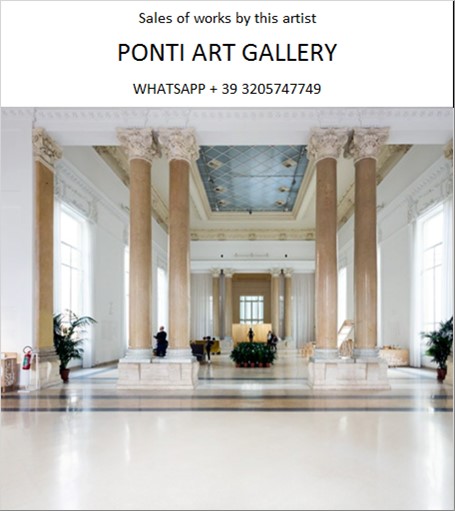Ponti Art Gallery is interested in buying and selling works
of art by this artist.

Gino De-Dominicis Biography
Gino De Dominicis was an Italian artist born in Ancona in 1947 and passed away in Rome on November 29, 1998. He emerged as a controversial figure in the Italian art scene post-World War II, distinguishing himself through a diverse array of techniques and self-identifications as a painter, sculptor, philosopher, and architect. De Dominicis' work is characterized by its independence from contemporary fashions and neo-avant-garde groups, making it difficult to categorize within specific artistic currents such as Arte Povera, Transavanguardia, or conceptual art, all of which he rejected.
De Dominicis cultivated an aura of mystery and unavailability around himself, selectively participating in exhibitions and public appearances. This approach contributed to his reputation, which developed as much from his absence as from his presence. Notably, in 1999, Harald Szeemann dedicated an exhibition to him at the 48th Venice Biennale. In 2010, the MAXXI in Rome hosted the first major retrospective of De Dominicis' work, curated by Achille Bonito Oliva, marking the museum's inaugural exhibition. Further showcasing his international recognition, in 2017, the Luxembourg & Dayan gallery in London held a solo exhibition of his works from the collection of Guntis Brands.
De Dominicis often drew inspiration from mythical and epic figures, such as Gilgamesh, the Sumerian king seeking immortality, and Urvashi, the Hindu Veda goddess of beauty. His paintings explore themes of immortality, beauty, and esotericism, featuring surreal imagery and figures undergoing various transformations. His approach to painting, using basic materials like tempera and pencil on board, emphasized the human figure and conveyed a sense of enigmatic suspension.
In his lifetime, De Dominicis was known for his provocative acts and exhibitions. For instance, at a significant exhibition in Venice, he presented a living person with Down syndrome as an art piece, challenging conventional notions of art and ethics. This act was widely discussed and even referenced by notable figures such as poet Eugenio Montale in his Nobel Lecture.
De Dominicis' return to painting in the 1980s marked a renewed interest in exploring the coexistence of mythical figures through his art. One of his notable works from this period, "Senza titolo (Untitled)," 1988, features two white silhouettes on a black panel, separated by the image of a prism, symbolizing a moment of revelation between the figures.
Throughout his career, De Dominicis maintained a critical stance towards photography, attributing no documentary or publicity value to it. This choice further contributed to the mystique surrounding his work and persona. His exhibitions spanned various venues, including Galleria L’Attico and Galleria Pieroni in Rome, Galleria Toselli in Milan, and Galleria Mazzoli in Modena, among others.
De Dominicis' work and life were marked by a continuous exploration of the boundaries between reality and myth, the material and the immaterial. He viewed the artist as a figure capable of opposing predetermination in life, a theme that resonates throughout his oeuvre. His legacy is that of an artist who defied convention, seeking to explore and express the infinite possibilities of human creativity and imagination.
Gino De-Dominicis Quotes and
Sales of Works
Ponti Art Gallery selects and deals with paintings by the
artist. Upon request, we provide free estimates and
evaluations, communicate prices, quotations, and current
market values.
If you are interested in BUYING or SELLING works by the
artist, contact us immediately.
If you wish to sell or receive an evaluation of the
works:
Send us a frontal photo of the painting, one of the back,
and one of the signature. Also, indicate the dimensions of
the work. Inform us about the purchase origin of the work
and any kind of available documentation (purchase
receipts, certificates of authenticity, publications). One
of our operators will respond to you on the same day. We
guarantee maximum confidentiality and extreme
professionalism.
If you wish to purchase works by the painter: Contact us
and let us know your request. We will inform you about the
available works. We also offer the possibility to
subscribe to our NEWSLETTER, through which you will be
informed at the beginning of each month about the latest
acquisitions of the art gallery.
You can send us pictures of the work:
